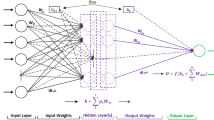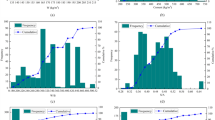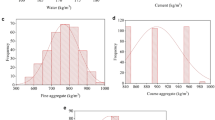Abstract
Plurality of parameters that influenced the compressive strength of concrete and the nonlinear relationship of parameters and concrete properties caused researchers to turn to the Self Organization Feature Map systems. In a SOFM network, the processing units are located at the nodes of a one-dimensional, two-dimensional, or more dimensional network. In a competitive learning process, units are regulated based on input patterns. The location of the units in the network is regulated so that a significant coordinates system develops on the network for input features. Competitive learning which is employed in such networks is called unsupervised learning. In the present study, 173 concrete samples with different characteristics have been used. Networks used in the current research are Self Organization Feature Map networks of constant weight, including Kohonen network. Slump parameters, water/cement ratio, maximum size of gravel, sand and cement content were considered as the input values, and concrete compressive strength was calculated using this model. The structures of all SOFM systems were optimized using genetic algorithms. To verify the accuracy of the model, it was compared with statistical models and artificial neural networks. The results showed that the Self Organization Feature Map systems, which were optimized using genetic algorithm, had more accuracy than other models in predicting the compressive strength of concrete.















Similar content being viewed by others
References
Alshihri MM, Azmy AM, El-Bisy MS (2009) Neural networks for predicting compressive strength of structural light weight concrete. Constr Build Mater 23(6):2214–2219
Gavin J, Bowden GC (2005) Input determination for neural network models in water resources applications. Part 1—background and methodology. J Hydrol 301(1–4):75–92
Kohonen T (1988) Self-organization and associative memory. Springer-Verlag, Berlin
Nazari A, Riahi S (2011) Prediction split tensile strength and water permeability of high strength concrete containing TiO2 nanoparticles by artificial neural network and genetic programming. Compos Part B Eng 42(3):473–488
Özcan F, Atiş CD, Karahan O, Uncuoğlu E, Tanyildizi H (2009) Comparison of artificial neural network and fuzzy logic models for prediction of long-term compressive strength of silica fume concrete. Adv Eng Softw 40(9):856–863
Sarıdemir M (2011) Empirical modeling of splitting tensile strength from cylinder compressive strength of concrete by genetic programming. Expert Syst Appl 38(11):14257–14268
Sarıdemira M, Topçu İB, Özcan F, Severcan MH (2009) Prediction of long-term effects of GGBFS on compressive strength of concrete by artificial neural networks and fuzzy logic. Constr Build Mater 23(3):1279–1286
Słoński M (2010) A comparison of model selection methods for compressive strength prediction of high-performance concrete using neural networks. Comput Struct 88(21–22):1248–1254
Sobhani J, Najimi M, Pourkhorshidi AR, Parhizkar T (2010) Prediction of the compressive strength of no-slump concrete: a comparative study of regression, neural network and ANFIS models. Constr Build Mater 24(5):709–718
Srinivas G, Vasanth P, Miroslav T (2005) Self-organizing feature map with improved performance by non-monotonic variation of the learning rate. freepatentsonline (FPO)
Uysal M, Tanyildizi H (2012) Estimation of compressive strength of self compacting concrete containing polypropylene fiber and mineral additives exposed to high temperature using artificial neural network. Constr Build Mater 27(1):404–414
Author information
Authors and Affiliations
Corresponding author
Rights and permissions
About this article
Cite this article
Nikoo, M., Zarfam, P. & Sayahpour, H. Determination of compressive strength of concrete using Self Organization Feature Map (SOFM). Engineering with Computers 31, 113–121 (2015). https://doi.org/10.1007/s00366-013-0334-x
Received:
Accepted:
Published:
Issue Date:
DOI: https://doi.org/10.1007/s00366-013-0334-x




